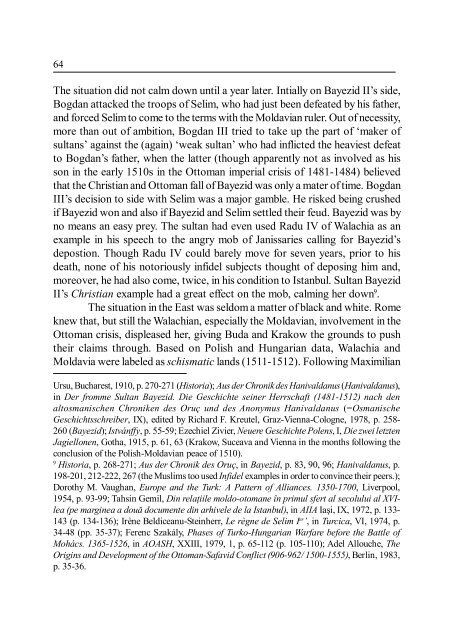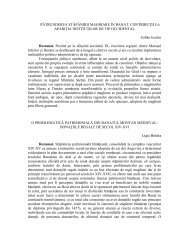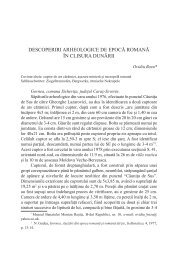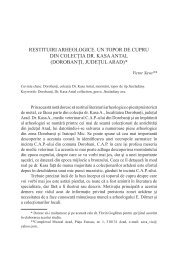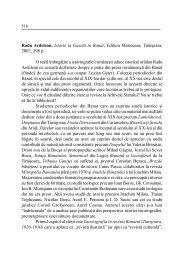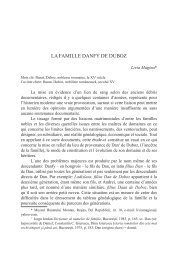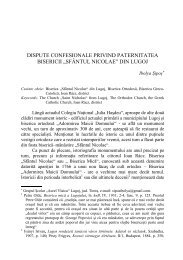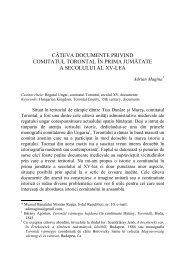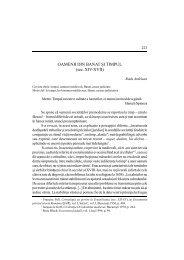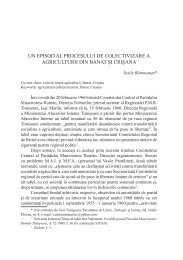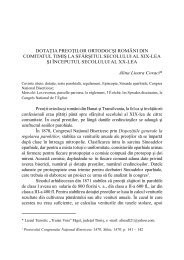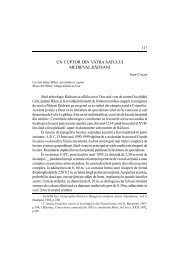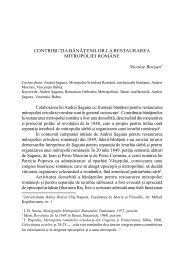Alexandru Simon - Banatica
Alexandru Simon - Banatica
Alexandru Simon - Banatica
Create successful ePaper yourself
Turn your PDF publications into a flip-book with our unique Google optimized e-Paper software.
64<br />
The situation did not calm down until a year later. Intially on Bayezid II’s side,<br />
Bogdan attacked the troops of Selim, who had just been defeated by his father,<br />
and forced Selim to come to the terms with the Moldavian ruler. Out of necessity,<br />
more than out of ambition, Bogdan III tried to take up the part of ‘maker of<br />
sultans’ against the (again) ‘weak sultan’ who had inflicted the heaviest defeat<br />
to Bogdan’s father, when the latter (though apparently not as involved as his<br />
son in the early 1510s in the Ottoman imperial crisis of 1481-1484) believed<br />
that the Christian and Ottoman fall of Bayezid was only a mater of time. Bogdan<br />
III’s decision to side with Selim was a major gamble. He risked being crushed<br />
if Bayezid won and also if Bayezid and Selim settled their feud. Bayezid was by<br />
no means an easy prey. The sultan had even used Radu IV of Walachia as an<br />
example in his speech to the angry mob of Janissaries calling for Bayezid’s<br />
depostion. Though Radu IV could barely move for seven years, prior to his<br />
death, none of his notoriously infidel subjects thought of deposing him and,<br />
moreover, he had also come, twice, in his condition to Istanbul. Sultan Bayezid<br />
II’s Christian example had a great effect on the mob, calming her down 9 .<br />
The situation in the East was seldom a matter of black and white. Rome<br />
knew that, but still the Walachian, especially the Moldavian, involvement in the<br />
Ottoman crisis, displeased her, giving Buda and Krakow the grounds to push<br />
their claims through. Based on Polish and Hungarian data, Walachia and<br />
Moldavia were labeled as schismatic lands (1511-1512). Following Maximilian<br />
Ursu, Bucharest, 1910, p. 270-271 (Historia); Aus der Chronik des Hanivaldanus (Hanivaldanus),<br />
in Der fromme Sultan Bayezid. Die Geschichte seiner Herrschaft (1481-1512) nach den<br />
altosmanischen Chroniken des Oruç und des Anonymus Hanivaldanus (=Osmanische<br />
Geschichtsschreiber, IX), edited by Richard F. Kreutel, Graz-Vienna-Cologne, 1978, p. 258-<br />
260 (Bayezid); Istvánffy, p. 55-59; Ezechiel Zivier, Neuere Geschichte Polens, I, Die zwei letzten<br />
Jagiellonen, Gotha, 1915, p. 61, 63 (Krakow, Suceava and Vienna in the months following the<br />
conclusion of the Polish-Moldavian peace of 1510).<br />
9 Historia, p. 268-271; Aus der Chronik des Oruç, in Bayezid, p. 83, 90, 96; Hanivaldanus, p.<br />
198-201, 212-222, 267 (the Muslims too used Infidel examples in order to convince their peers.);<br />
Dorothy M. Vaughan, Europe and the Turk: A Pattern of Alliances. 1350-1700, Liverpool,<br />
1954, p. 93-99; Tahsin Gemil, Din relaţiile moldo-otomane în primul sfert al secolului al XVIlea<br />
(pe marginea a două documente din arhivele de la Istanbul), in AIIA Iaşi, IX, 1972, p. 133-<br />
143 (p. 134-136); Irène Beldiceanu-Steinherr, Le règne de Selim I er ’, in Turcica, VI, 1974, p.<br />
34-48 (pp. 35-37); Ferenc Szakály, Phases of Turko-Hungarian Warfare before the Battle of<br />
Mohács. 1365-1526, in AOASH, XXIII, 1979, 1, p. 65-112 (p. 105-110); Adel Allouche, The<br />
Origins and Development of the Ottoman-Safavid Conflict (906-962/ 1500-1555), Berlin, 1983,<br />
p. 35-36.


